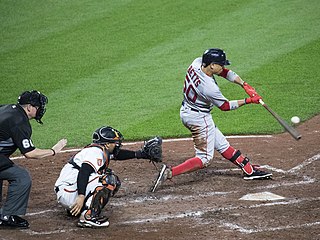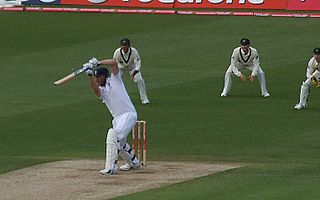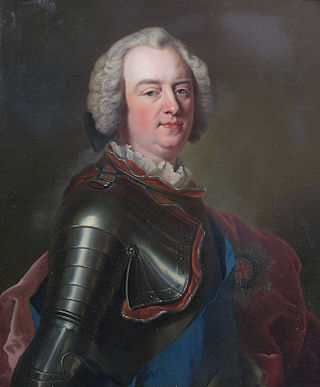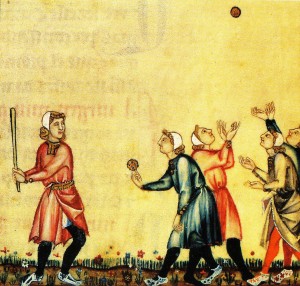
Baseball is a bat-and-ball sport played between two teams of nine players each, taking turns batting and fielding. The game occurs over the course of several plays, with each play generally beginning when a player on the fielding team, called the pitcher, throws a ball that a player on the batting team, called the batter, tries to hit with a bat. The objective of the offensive team is to hit the ball into the field of play, away from the other team's players, allowing its players to run the bases, having them advance counter-clockwise around four bases to score what are called "runs". The objective of the defensive team is to prevent batters from becoming runners, and to prevent runners' advance around the bases. A run is scored when a runner legally advances around the bases in order and touches home plate.

Rounders is a bat-and-ball game played between two teams. Rounders is a striking and fielding team game that involves hitting a small, hard, leather-cased ball with a wooden, plastic, or metal bat that has a rounded end. The players score by running around the four bases on the field.

Backyard cricket, also known as Bat ball, street cricket, beach cricket, corridor cricket, garden cricket, and box cricket, is colloquially referred to as gully cricket in the Indian subcontinent. This informal variant of cricket is a universally inclusive game, welcoming all genders and ages. It is typically played in various non-traditional venues such as gardens, backyards, streets, parks, carparks, beaches, and any area not specifically designed for the sport.

An all-rounder is a cricketer who regularly performs well at both batting and bowling. Although all bowlers must bat and quite a handful of batsmen do bowl occasionally, most players are skilled in only one of the two disciplines and are considered specialists. Some wicket-keepers have the skills of a specialist batter and have been referred to as all-rounders, but the term wicket-keeper-batter is more commonly applied to them, even if they are substitute wicket keepers who also bowl.
The history of baseball can be broken down into various aspects: by era, by locale, by organizational-type, game evolution, as well as by political and cultural influence. The game evolved from older bat-and-ball games already being played in England by the mid-18th century. This game was brought by immigrants to North America, where the modern version developed. By the late 19th century, baseball was widely recognized as the national sport of the United States. Baseball is popular in North America and parts of Central and South America, the Caribbean, and East Asia, particularly in Japan, South Korea, and Taiwan.
The question of the origins of baseball has been the subject of debate and controversy for more than a century. Baseball and the other modern bat, ball, and running games – stoolball, cricket and rounders – were developed from folk games in early Britain, Ireland, and Continental Europe. Early forms of baseball had a number of names, including "base ball", "goal ball", "round ball", "fetch-catch", "stool ball", and, simply, "base". In at least one version of the game, teams pitched to themselves, runners went around the bases in the opposite direction of today's game, much like in the Nordic brännboll, and players could be put out by being hit with the ball. Just as now, in some versions a batter was called out after three strikes.

The sport of cricket has a known history beginning in the late 16th century. Having originated in south-east England, it became an established sport in the country in the 18th century and developed globally in the 19th and 20th centuries. International matches have been played since the 19th-century and formal Test cricket matches are considered to date from 1877. Cricket is the world's second most popular spectator sport after association football (soccer).

Kickball is a team sport and league game, similar to baseball. Like baseball, it is a safe haven game in which one team tries to score by having its players return a ball from home base to the field and then circle the bases. Meanwhile, the other team tries to stop them by tagging them "out" with the ball before they can return to the home base. However, instead of hitting a small, hard ball with a bat, players kick an inflated rubber ball; this makes it more accessible to young children. As in baseball, teams alternate half-innings. The team with the most runs after a predefined number of innings wins.
Cricket is a multi-faceted sport with different formats, depending on the standard of play, the desired level of formality, and the time available. One of the main differences is between matches limited by time in which the teams have two innings apiece, and those limited by number of overs in which they have a single innings each. The former, known as first-class cricket if played at the senior level, has a scheduled duration of three to five days ; the latter, known as limited overs cricket because each team bowls a limit of typically 50 overs, has a planned duration of one day only. A separate form of limited overs is Twenty20, originally designed so that the whole game could be played in a single evening, in which each team has an innings limited to twenty overs.
Baseball and cricket are the best-known members of a family of related bat-and-ball games. Both have fields that are 400 feet (120 m) or more in diameter between their furthest endpoints, offensive players who can hit a thrown/"bowled" ball out of the field and run between safe areas to score runs (points) at the risk of being gotten out, and have a major game format lasting about 3 hours.

It has been suggested that the origin of cricket can be traced back to Flemish emigrants residing in the south of England since the medieval period. The game was first played in the sheep-rearing country of the south-east, where the short grass of the fields made it possible to bowl a ball of wool at a target. That target was usually the wicket-gate of the sheep pasture, which was defended with a bat in the form of a shepherd’s crooked staff.
In the years from 1726 to 1750, cricket became an established sport in London and the south-eastern counties of England. In 1726, it was already a thriving sport in the south east and, though limited by the constraints of travel at the time, it was slowly gaining adherents in other parts of England, its growth accelerating with references being found in many counties. Having been essentially a rural pastime for well over a century, cricket became a focus for wealthy patrons and gamblers whose interests funded its growth throughout the 18th century.

Vigoro is a team sport, played mainly by women in Australia, that originally combined elements of cricket and tennis, although in its current form it may be more similar to cricket and baseball.

Bat-and-ball games are field games played by two opposing teams. Action starts when the defending team throws a ball at a dedicated player of the attacking team, who tries to hit it with a bat and run between various safe areas in the field to score runs (points). The defending team can use the ball in various ways against the attacking team's players to force them off the field when they are not in safe zones, and thus prevent them from further scoring. The best known modern bat-and-ball games are cricket and baseball, with common roots in the 18th-century games played in England.
British baseball, also known colloquially in Wales as Welsh baseball, is a bat-and-ball game played in Wales, England, and to a lesser extent in Ireland and Scotland. The game emerged as a distinct sport in Merseyside, Gloucester and South Wales at the end of the 19th Century, drawing on the much older game of rounders. Teams in all locations played under the codified rules created by the National Rounders Association (later renamed as the, with the game in Wales locally organised first by the South Wales Baseball Association,, who in turn were replaced by the Welsh Baseball Union. The Irish Baseball Union were formed in 1933. Both the English Baseball Association and Welsh Baseball Union are members of the International Baseball Board.
The English Baseball Association is the governing body of the traditional code of British baseball in England, with responsibility for overseeing all aspects of the domestic game and the body responsible for the creation and development of the original rules of the game. The EBA was formed in 1892, though this was a continuation of the much older National Rounders Association, who created the first codified rules of British baseball, between 1887 and 1888. The EBA is based in Liverpool and is a member of the International Baseball Board.

Cricket is a bat-and-ball game played between two teams of eleven players on a field at the centre of which is a 22-yard (20-metre) pitch with a wicket at each end, each comprising two bails balanced on three stumps. The batting side scores runs by striking the ball bowled at one of the wickets with the bat and then running between the wickets, while the bowling and fielding side tries to prevent this and dismiss each batter. Means of dismissal include being bowled, when the ball hits the stumps and dislodges the bails, and by the fielding side either catching the ball after it is hit by the bat, but before it hits the ground, or hitting a wicket with the ball before a batter can cross the crease in front of the wicket. When ten batters have been dismissed, the innings ends and the teams swap roles. The game is adjudicated by two umpires, aided by a third umpire and match referee in international matches. They communicate with two off-field scorers who record the match's statistical information.
Sport in Sussex forms an important part of the culture of Sussex. With a centuries-long tradition of sport, Sussex has played a key role in the early development of both cricket and stoolball. Cricket is recognised as having been formed in the Weald and Sussex CCC is England's oldest county cricket club. Slindon Cricket Club dominated the sport for a while in the 18th century. The cricket ground at Arundel Castle traditionally plays host to a Duchess of Norfolk's XI which plays the national test sides touring England. The sport of stoolball is also associated with Sussex, which has a claim to be where the sport originated and certainly where its revival took place in the early 20th century. Sussex is represented in the Premier League by Brighton & Hove Albion and in the Football League by Crawley Town. Brighton has been in the Premier League since 2017 and has been a League member since 1920, whereas Crawley was promoted to the League in 2011. Brighton & Hove Albion W.F.C. play in the FA Women's Super League from 2017. Sussex has had its own football association, since 1882 and its own football league, which has since expanded into Surrey, since 1920. In horse racing, Sussex is home to Goodwood, Fontwell Park, Brighton and Plumpton. The All England Jumping Course show jumping facility at Hickstead is situated 8 miles (13 km) north of Brighton and Hove.

Cricket in Sussex refers to the sport of cricket in relation to its participation and history within Sussex, England. One of the most popular sports in Sussex, it is commonly believed that cricket was developed in Sussex and the neighbouring counties of Kent and Surrey. Records from 1611 indicate the first time that the sport was documented in Sussex; this is also the first reference to cricket being played by adults. The first reference to women's cricket is also from Sussex and dates from 1677; a match between two Sussex women's teams playing in London is documented from 1747. Formed in 1839, Sussex County Cricket Club is believed to be the oldest professional sports club in the world and is the oldest of the county cricket clubs. Sussex players, including Jem Broadbridge and William Lillywhite were instrumental in bringing about the change from underarm bowling to roundarm bowling, which later developed into overarm bowling. For some time roundarm bowling was referred to as 'Sussex bowling'.













